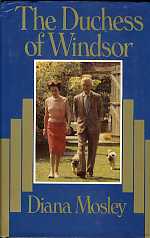
Wallis, Duchess of Windsor, known as Wallis Simpson, was an American socialite and wife of the Duke of Windsor, the former British king Edward VIII. Their intention to marry and her status as a divorcée caused a constitutional crisis that led to Edward's abdication.

Mary of Teck was Queen consort of the United Kingdom and the British Dominions from the accession of her husband, King George V, in 1910 until his death in 1936. She was concurrently Empress consort of India.
Morganatic marriage, sometimes called a left-handed marriage, is a marriage between people of unequal social rank, which in the context of royalty prevents the husband's titles and privileges being passed on to the wife and/or any children born of the marriage.

Diana, Lady Mosley, usually known as Diana Mitford, was one of the Mitford sisters. She was first married to Bryan Walter Guinness, heir to the barony of Moyne, and with whom she was part of the Bright young things social group of Bohemian young aristocrats and socialites in 1920s London. Her marriage ended in divorce as she was pursuing a relationship with Sir Oswald Mosley, 6th Baronet of Ancoats, leader of the British Union of Fascists. She married Mosley at the home of Joseph Goebbels in 1936, with Adolf Hitler as guest of honour. Subsequently, her involvement with Fascist political causes resulted in three years' internment during the Second World War. She later moved to Paris and enjoyed some success as a writer. In the 1950s, she contributed diaries to Tatler and edited the magazine The European. In 1977, she published her autobiography, A Life of Contrasts, and two more biographies in the 1980s. Her appearance on the BBC's Desert Island Discs in 1989 was controversial. She was also a regular book reviewer for Books & Bookmen and later at The Evening Standard in the 1990s. A family friend, James Lees-Milne, wrote of her beauty, "She was the nearest thing to Botticelli's Venus that I have ever seen". She was described as "unrepentant" about her previous political associations by obituary writers such as the historian Andrew Roberts.

In 1936, a constitutional crisis in the British Empire arose when King-Emperor Edward VIII proposed to marry Wallis Simpson, an American socialite who was divorced from her first husband and was pursuing the divorce of her second.

Duke of Windsor was a title in the Peerage of the United Kingdom. It was created on 8 March 1937, for former King Edward VIII, following his abdication on 11 December 1936. The dukedom takes its name from the town where Windsor Castle, a residence of English monarchs since the time of Henry I, is situated. Windsor has been the house name of the royal family since 1917.

Prince George, Duke of Kent, was a member of the British royal family, the fourth son of King George V and Queen Mary. He was the younger brother of Edward VIII and George VI.

This is a list of those who have held the title Princess of the United Kingdom from the accession of George I in 1714. This article deals with both princesses of the blood royal and women who become princesses upon marriage.

Succession to the British throne is determined by descent, sex, legitimacy, and religion. Under common law, the Crown is inherited by a sovereign's children or by a childless sovereign's nearest collateral line. The Bill of Rights 1689 and the Act of Settlement 1701 restrict succession to the throne to the legitimate Protestant descendants of Sophia of Hanover who are in "communion with the Church of England". Spouses of Roman Catholics were disqualified from 1689 until the law was amended in 2015. Protestant descendants of those excluded for being Roman Catholics are eligible.
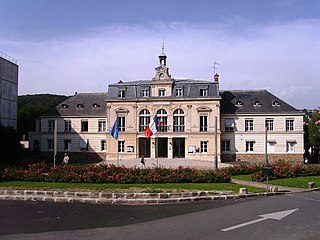
Orsay is a commune in the Essonne department in Île-de-France in northern France. It is located in the southwestern suburbs of Paris, France, 20.7 km (12.9 mi) from the centre of Paris.
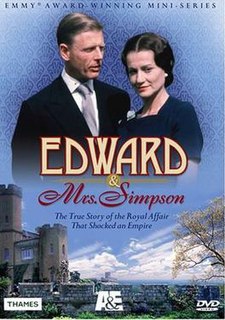
Edward & Mrs. Simpson is a seven-part British television series that dramatises the events leading to the 1936 abdication of King Edward VIII, who gave up his throne to marry the twice-divorced American Wallis Simpson.

John Theodore Goddard was an English solicitor and founder of the law firm Theodore Goddard (TG) based in London. The firm merged with Addleshaw Booth & Co on 1 May 2003 to become Addleshaw Goddard. Goddard was appointed by Wallis Simpson as an adviser to her during divorce proceedings and in relation to her involvement during the United Kingdom abdication Crisis of 1936.
Events from the year 1936 in the United Kingdom.

Peregrine Francis Adelbert Cust, 6th Baron Brownlow, often known as Perry Brownlow, was a British peer and courtier. He was the son of Adelbert Salusbury Cockayne Cust, 5th Baron Brownlow, and his wife Maud Buckle.
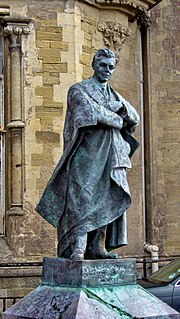
Edward VIII and Wallis Simpson have been depicted in culture, both biographical and fictional, following his abdication in 1936 and their marriage the following year.

Edward VIII, was King of the United Kingdom and the Dominions of the British Empire, and Emperor of India, from 20 January 1936 until his abdication on 11 December of that year.
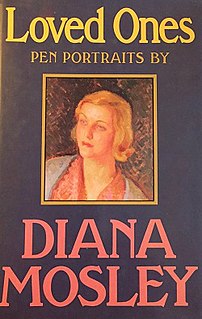
Loved Ones is a 1985 collection of pen portraits by Diana Mitford. It was published by Sidgwick & Jackson. In 2008, three of the portraits were republished in the collection, The Pursuit of Laughter.
Anne Sebba is an award-winning British biographer, writer, lecturer and journalist. She is the author of nine non-fiction books for adults, two biographies for children and several introductions to reprinted classics.
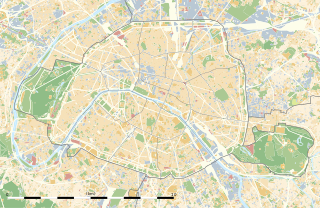
The 4 Route du Champ d'Entraînement, Paris, is a villa in the Bois de Boulogne close to Neuilly-sur-Seine. The house is owned by the city of Paris and was the Paris home of the Duke and Duchess of Windsor.
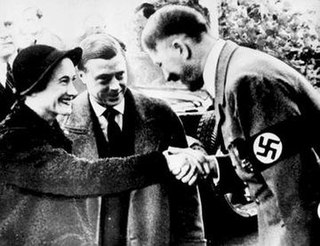
Edward, Duke of Windsor, and Wallis, Duchess of Windsor, visited Nazi Germany in October 1937. The Duke had abdicated the British throne in December 1936, and his brother George VI became king. Edward had been given the title Duke of Windsor and married Wallis Simpson in June 1937. He appears to have been sympathetic to Germany in this period and, that September, announced his intention to travel privately to Germany to tour factories. His interests, officially into researching the social and economic conditions of the working classes, were against the backdrop of looming war in Europe. The Duke's supporters saw him as a potential peacemaker between Britain and Germany, but the British government refused to sanction such a role and was against the tour, suspecting that the Nazis would use the Duke's presence for propaganda. Windsor was keen that his wife—who had been rejected by the British establishment—experience a state visit as his consort. He promised the government to keep a low profile, and the tour went ahead between 12 and 23 October.
